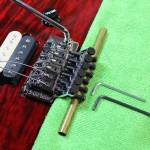Having a memory slip in the middle of a performance is probably one of the more embarrassing things that can happen to a musician. For many performers, it is the single most anxiety-producing aspect of live performances. Yet even the best are not immune to memory issues – even major concert artists have been known to make memory slips from time to time.
I’ve had my share of memory slips of course, from the slightly embarrassing variety (blanking out in a small informal concert) to the truly mortifying (getting lost in an unaccompanied Bach piece in the second round of an international competition). Yet, when I was a student, I never learned how to memorize music. Or more specifically, I never developed a trustworthy system for memorizing music.
Good “remember-ers” tend to recognize that their memory is not infallible, and not onlyuse memory strategies, but know which ones work for them and which ones don’t. Poor remember-ers tend to assume (or hope) that they won’t forget, and don’t make explicit use of any particular strategies. I have to admit, I was in this second group for most of my life.
Entire books have been written on memory, and psychologists and neuroscientists are making new discoveries about learning and memory all the time. Though much of it is actually quite fascinating, a discussion of the nuts and bolts of memory is beyond the scope of this post. For now, I will just go directly to the good stuff – four key memory strategies (and their implications for musicians), that will become indispensible in your attempts to develop a more “bulletproof” memory.
Without further ado, here they are.
Strategy #1: Rehearsal
This is an obvious one, perhaps, but repetition and practice do increase the strength with which the music is encoded into our memory. However, what many of us do might be better described as mindless repetition, or merely playing something over and over without really thinking about what we are doing – just hoping that muscle memory alone will take care of business on-stage.
The goal here is to a) vary the different ways in which we practice and encode the music into our memory and b) force ourselves to recall the information we need via different methods.
For instance:
- See if you can hum or solfege the entire piece without referring to the score.
- See if you can “play” the piece on your instrument – without making a sound.
- See if you can visualize the score in your head and mentally “play” the piece through from beginning to end.
- See if you can mentally “hear” yourself play the piece through from beginning to end.
- Try closing your eyes and trying to mentally rehearse the piece from beginning to end, “feeling” yourself play the piece on your instrument, “hearing” the desired sounds being produced, and perhaps even “seeing” the notes pass by on the score. Can you get through the piece without a hitch?
Great! On to the next strategy!
Strategy #2: Organization
Organization refers to arranging the material to be learned into groups, subgroups, and hierarchies of subgroups.
In other words, take a look at the musical structure of the piece? How does your part fit with the other instrument(s) involved? What are the actual note values, the dynamics, the tempo markings, etc.?
Ready for a challenge? Sit down with some empty staff paper and write out by hand, the entire piece from memory.
Got it? Next!
Strategy #3: Elaboration
Elaboration means going above and beyond mere repetition and rote learning, by working to assign meaning to the material.
This means to make the piece more than just a collection of notes and sounds, but to give it more life by identifying mental images, scenes, stories, dialogue, faces, personalities, characteristics, emotions, and so on, that can be linked to the notes, gestures, phrases, sections, and movements that make up a piece of music.
The more vivid and specific these elements are, and the clearer you are about how to produce these through your music, the more strongly the music will be etched into your brain and the more likely it is that you will be able to convey your ideas to an audience to begin with.
When I was a child, I would sit down with a new piece, and work my way through the score, literally creating visual images to go along with different phrases and sections of the piece and using colored pencils to draw/color these into the actual music itself. My old scores look like coloring books. Does it seem like something only kids would do? Maybe, but I never had any memory issues until I “outgrew” this strategy and stopped doing it.
Create a vivid set of scenes, characters, etc. for each of the sections and phrases of the piece. Draw them on paper if you’d like, and be very clear in your own mind about what you see.
Strategy #4: Temple of Loci
I’ve seen this strategy referred to by other terms (e.g. “memory castle”), but the Temple of loci strategy is where one links new material with the elements of a familiar routine or location, such as one’s daily commute, or one’s hometown, or current residence.
Malcolm Lowe once noted that he conceptualized each piece as a journey or trip, imagining the beginning of a piece as the starting point (e.g. perhaps walking out the door of his house), and then tracing a route through the piece to the end along an imaginary path (for instance, stopping by a park, sitting on a park bench, feeding the birds, seeing a mime put on a show, walking through a grove of trees, getting splashed by the fountains, watching some kids play catch, grabbing a hot dog, meeting up with a friend, reminiscing on good times together, walking back home, etc.).
Do you have your piece “mapped” out?
If you have gone through all four of these strategies, and applied each of them in earnest, you will reach the point where you can’t get the music out of your head even if you wanted to.
But this all sounds like an awful lot of work…
Is it a bit much? Well, yes perhaps, but how much fun is mindless repetition?



